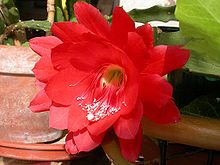- Disocactus ×hybridus
-
Orchid Cactus Disocactus ×hybridus Scientific classification Kingdom: Plantae (unranked): Angiosperms (unranked): Eudicots (unranked): Core eudicots Order: Caryophyllales Family: Cactaceae Subfamily: Cactoideae Tribe: Hylocereeae Genus: Disocactus Species: D. ×hybridus Binomial name Disocactus ×hybridus
(Van Geel) BarthlottDisocactus ×hybridus is a hybrid between Disocactus phyllanthoides and Disocactus speciosus. It is perhaps the most commonly grown Orchid Cactus and seems to survive and flower under most conditions. It has a very complex taxonomic history and has been mistaken for Disocactus ackermannii for a long time. The name Cactus jenkinsonii McIntosh (1829) might be an older name, but there is no combinaton under Disocactus.
History
History In 1824, Mr. George Ackermann brought a part of a stem with him from Mexico and gave that to Mr. Tate who succeeded in flowering the specimen. Another specimen raised from Mexican seeds confirmed that this was really a novelty from Mexico and not a hybrid. The species was soon lost in cultivation. During the latter half of the 19th century, when cacti gave away to ferns, palms and orchids, only the toughest survived and as D. ackermannii is quite tricky it soon became lost in cultivation. About the same time some gardener succeeded in crossing D. phyllanthoides and D. speciosus producing a lovely red flowered hybrid. Being a vigorous, hardy, free-flowering plant, almost impossible to kill, it survived in collections. Unfortunately it was confused with the true D. ackermannii so when Britton & Rose published their remarkable publication: The Cactaceae, the switch had been made and the true species was forgotten. What Britton and Rose describes under Epiphyllum ackermanni is the hybrid, not the species. In 1943, Charles Gilles rediscovered the species in high, nearly unclimbable trees near Jalapa. He managed to collect living material and it was soon evident that the plant in cultivation was not the plant of Haworth. This hybrid is today correctly referred to as Disocactus x hybridus 'Ackermannii'
Description
Stems flat to triangular, often quite thick and succulent. Flowers more or less funnelform, usually orange to red. Stigma lobes white, never lavender.
Cultivars
This cross has been remade many times creating several cultivars. However, many of them are confused today and cannot be identified.
- 'Ackermannii' - orange to red, small-medium flower. Stems flat or triangular. This has unfortunately been named 'Ackermannii Hybridus' in the Directory of Epiphyllum Society of America, to separate it from the wild species, Disocactus ackermannii. But this has perhaps confused things even further.
- 'Ackermannii Alba' - white with pink outer tepals. Said to have been an albine sport of the above.
- 'Bollwillerianus' - flowers carmine-scarlet, small-medium.
- 'Coccineus' - red medium flower.
- 'Curtisii' - scarlet medium flower.
- 'Devauxii' - scarlet-red small flower.
- 'Hansei' - rose. This is a backcross between D. x hybridus and D. speciosus.
- 'Holly Gate' - flower extra large, bright purple with red midstripe; outer tepals red-orange, longer than inner ones. Growth sturdy and erect, mostly triangular.
- 'Ignescens' - fiery dark scarlet-red with overlapping inner tepals. Medium-large.
- 'Jacques Courant' - flower blue-violet with red. Red dots at the base. Stems with waxy bluish overcast.
- 'Jenkinsonii' - flower bright orange-red with wide inner tepals, opens nearly flat, 10 cm in Ø. Areoles bearing a few spines and bristles. Flat and triangular growth. Britton & Rose describes the fruit as globular and purple, 2,5 cm in Ø.
- 'Johnson's Beauty' - flower light red with orange midstripe. Overlapping funnel form, small. Thick flat growth.
- 'Lateritius' - also listed as 'Speciosissimus Lateritius' or 'Superbus Lateritius'. Flower brick red, 15,5 cm long with narrowly lanceolate, acuminate tepals.
- 'Loudonii' - flower yellow.
- 'Maidens Erleigh' - flower medium. Inner tepals lilac pink, broad, outer tepals vermillion. Triangular growth.
- May Fly' - flower red.
- 'Mexicanus' - salmon rose to salmon coral with cerice tones in the base, inner tepals narrow. Medium-large. Fragrant. Waxy green growth. Might not be of this parentage as both parents lack fragrance.
- 'Multiflorus' - flower lustrious scarlet-red, medium.
- 'Orange Glow' - flower orange, outer tepals daker, small. Overlapping bell form. Thick flat growth.
- 'Rongo' - red, similar to 'Jenkinsonii'.
- 'Rote Feder' - red to scalet, inner tepals often with narrow purple margins, medium-large. All tepals deeply incised. Thick flat and triangular growth.
- 'Vandesii' - deep red, large.
- 'Vitellinus' - no record.
- 'Wee Bea' - flower solid pink, small, overlapping cup and saucer form. tall flat growth.
Categories:
Wikimedia Foundation. 2010.

